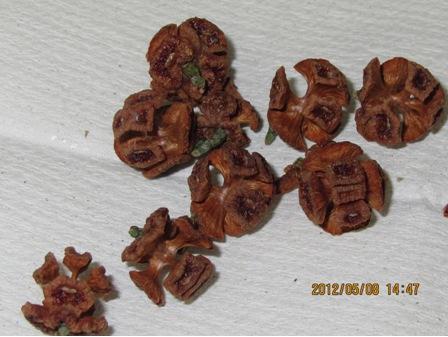– Radioautograph of Japanese Cypress Leaves from Iitate-mura, Fukushima (EX-SKF, May 27, 2012):
Dr. Satoshi Mori of Tokyo University has a radioautograph of Japanese cypress leaves that he took from Iitate-mura in Fukushima Prefecture last year in his blog. He says he cannot help feeling pity for the tree:
From Dr. Mori’s blog (5/24/2012):
??????????????????????????????????????????????????????????????????
This picture of Japanese cypress cultivated in Komiya District of Iitate-murawas was taken in the fall of last year. I also took the leaves and female cones at the height I was able to reach.
??????????????WINEP????????????(2011/12/18 : ????????????????Cs-137???????????????????????????????)
I’ve already reported part of the study [of this cypress] in this blog. (http://moribin.blog114.fc2.com/blog-entry-1339.html)
????????????????????????????????????????????????????????
Today, I want to show you the radiation measurements of parts of the cypress tree and the radioautograph of the leaves.
????????????????????????Cs-137?????????????????????? ??Cs-134??????????????????????????????????????????????????????????????? ???????????????????????????????????????????????????????????????????????? ???????????????????????????????????????
In the simplified measurement [using NaI scintillation survey meter], the seeds were found with about 10,000 Bq/kg of cesium-137, as you see in the Table below. Cesium-134 must be about 70% of this amount, so the total cesium would be at least 17,000 Bq/kg. It is about one-seventh of the radioactivity of the leaves. When the female fruits are attached to the leaf-stems (rachis) the seeds remain inside the fruits, and there should be no external radiation exposure from radioactive dusts. So, I assume almost all the radioactivity in the seeds was translocated from the leaves and tree barks that were contaminated with radioactive cesium.
?????????????
??? Japanese Cypress Cs-137 (?????) ?? seeds 10709 ???? female cone shells 37639 ? leaves 74610 ??? rachis 166093 ????????????????????????????????????????????????????????????????????????????????? ??????????????????????????
Still, as I pressed the leaves and took the radioautograph, I couldn’t help feeling pity for the Japanese cypress that was doused everywhere on the leaves and rachis with radioactivity. This image of irradiation may speak more volumes than the mere numerical information.
????????????????????????????????????????????????????????????????????????????????????????????????????????????????????????????????
These seeds would have popped out of the female fruits, landed on the ground, and damaging the chromosomes of their embryo buds from internal radiation exposure and the external radiation exposure from the environment (several microsieverts/hour) they would have entered the germinating period and started cell division.
???????????????????????????????????????????????????????????????????????? ??????????????????????????????????????????????????????????????????
Any biology researcher would think about inhibition of germination due to chromosome disorders, or malformation even if they germinate. If it were animals, they would be the equivalent of miscarriage, stillbirth, malformation, weak constitution due to immune depression. I’ve already reported on the numerous cases of malformed branches and leaves in Chernobyl.
?????????????????????????????????????????????????????????????????
The radioautograph shows the leaves uniformly sprinkled with radioactive fallout and irradiated.
I asked Dr. Mori about specific example of chromosome disorders. He said there are many types of chromosome disorders, including the following:
- Normal structures (roots, stems, leaves) may not form because cell division is interrupted and cells become callused.
- Chloroplast may not form in the leaves, and the plant cannot do photosynthesis (no carbon dioxide assimilation); or mitochondria is not formed, and the plant cannot breathe (no oxygen absorption). In either case, the plant will die.
- Even if the plant survives, it cannot leave offspring if there is a formation disorder of pollens or ova.



